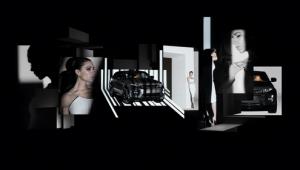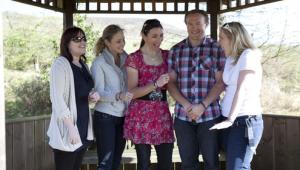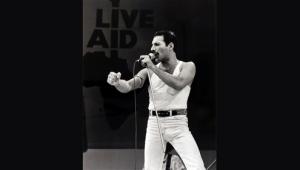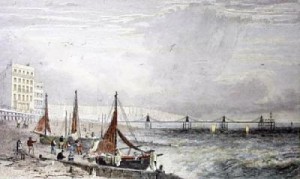
by editor | Apr 24, 2012 | Lead Story
Award winning British Fashion Designer, Victoria Beckham,
and the Land Rover Design team, led by Gerry McGovern,
have collaborated to create the Range Rover Evoque Special Edition.
 Featuring bespoke luxury and sporting details, the exclusively designed car will make its global debut in Beijing at an exclusive reveal event that will be streamed live online to a worldwide audience. The car will then be on display at the Beijing Auto Show, which runs from 25th April- 2nd May [press days 23rd – 24th April]
Featuring bespoke luxury and sporting details, the exclusively designed car will make its global debut in Beijing at an exclusive reveal event that will be streamed live online to a worldwide audience. The car will then be on display at the Beijing Auto Show, which runs from 25th April- 2nd May [press days 23rd – 24th April]
The first ever Land Rover to feature exclusive, hand-finished matt paint, the Special Edition will further extend the character of the Evoque through rose gold accents on the grille surround, badging and 20” gloss black forged alloy wheels. Inside, the 4 seat coupé will include soft, vintage-inspired leather seats with hand finished feature stitch, rose gold-plated accents and luxurious trim materials such as Grand black laquers and veneers, textured aluminium and mohair.
The Special Edition also comes complete with bespoke luxury accessories including a four- piece leather luggage set and hand-sewn leather wallet for the owner’s manual signed by Victoria Beckham.
Limited to a maximum of 200 vehicles to be sold worldwide, the Special Edition will be built at Halewood manufacturing facility in Liverpool and hand-finished by Land Rover’s Engineering to Order (ETO) division.
Deliveries for the Range Rover Evoque Special Edition will commence as early as October 2012.

by editor | Apr 17, 2012 | Lead Story
Seven Time Gold Medal Winning Paralympian
Sarah Storey Attributes Her Success To Her Circle of 5
 Despite 37% of all UK adults thinking that their success is down to their own merits, over a third (38%) think it is mostly down to the core people in their life.
Despite 37% of all UK adults thinking that their success is down to their own merits, over a third (38%) think it is mostly down to the core people in their life.
Sarah Storey, Paralympic cyclist and Links of London ambassador, believes that there are five core people in her life which have impacted and been invaluable to her progress in becoming a leading gold medal athlete. Sarah is supporting Links of London’s ‘Circle of 5’ campaign, which suggests we rely on a core group of 5 people to be successful.
Sarah Storey, seven times gold medal winner at the Paralympic games and twice British national track champion, commented: “Every successful person needs people behind them to drive them – I don’t know where I’d be without my friends, husband, trainers and parents. They push me to go that little bit further, inspire me and help me escape from it all when I need to. Without them I definitely wouldn’t have won my medals or be competing again this year.”
Dr Rob Yeung is a psychologist and researcher on success. Dr Yeung believes that the role each of the 5 people plays, falls into particular categories: Someone who inspires you, supports you, mentors you, someone you can escape with or confide in.
Dr Yeung said: “Many of us like to think that our own success is based on how we perform, but without valuable people in our lives – core people around us who support us – we may not achieve as much as we aspire to.”
Adding to this, the research commissioned by Links of London shows that 91% of all UK adults also look to family and friends, rather than famous people when finding role models.
Links of London are inviting the nation to recognise their own ‘circles of 5’ and to celebrate and reward these 5 important people with a talisman of unity and celebration. They have designed the Team GB band as part of their Official Jewellery Collection of London 2012 and Team GB. The Links of London ‘Circle of 5’ campaign encourages us to give the core 5 people in our lives a Team GB band as a thank you for aiding our successes. A red and blue woven band with a silver plaque engraved with Team GB, this band is a great way for you and your own ‘circle of 5’ to get behind the nation ahead of the Games and circulate a feeling of support and success.

by editor | Apr 5, 2012 | Lead Story
Wednesday 4th April 2012, New York: Today Jaguar confirms that it will bring an all-new sports car to production; the F-TYPE.
 Speaking at the New York auto show Adrian Hallmark, Global Brand Director, Jaguar Cars, confirmed: “We showed the C-X16 concept in September 2011, and the reaction to it has been so positive that we’ve accelerated our development of an all-new Jaguar sports car.
Speaking at the New York auto show Adrian Hallmark, Global Brand Director, Jaguar Cars, confirmed: “We showed the C-X16 concept in September 2011, and the reaction to it has been so positive that we’ve accelerated our development of an all-new Jaguar sports car.
“That car will be called the F-TYPE, and it will be unveiled in production form later this year. The core appeal of Jaguar’s cars is their sporting heart, and that heart will beat stronger than ever before in the F-TYPE. Its development is a vivid representation of the confidence and ambition of the Jaguar brand, and the desire amongst our engineers and design team to produce a world-leader in a market segment that we have been absent from for too long. But no longer – the F-TYPE is coming.”
Utilising Jaguar’s industry-leading knowledge of all-aluminium construction, the F-TYPE will launch as a convertible, and a strict two-seater with the focus uncompromisingly on delivering driver reward. A range of petrol engines will be available – including a new powerplant family – and all will deliver stunning sports car performance.
Today also marks the point that the F-TYPE’s rigorous development schedule moves to final on-road testing, with engineering prototypes now leaving Jaguar’s Castle Bromwich plant – the same plant at which the production cars will be built.
Ian Hoban, Jaguar’s Vehicle Line Director said: “The engineering development of the F-TYPE has focused on delivering a heightened level of dynamic driving reward. We are excited about our progress to date and are looking forward to soon being able to demonstrate what we have achieved.”
Ian Callum, Director of Design, said: “A true sports car needs to be pure in both its purpose and its form; to have the opportunity to produce such a car for Jaguar has been a privilege both for myself and for my team. The C-type, D-type and E-type Jaguars were all sports cars that held true to this principle in their era, and the F-TYPE will hold true to that same principle in its time, a time that is soon to arrive.”
The F-TYPE will join Jaguar’s existing range of cars – the XF saloon and Sportbrake, XJ saloon and XK coupe/convertible. Full F-TYPE technical and range details will be announced later in 2012.
It will go on sale in mid-2013.

by editor | Apr 2, 2012 | Lead Story
 ‘Don’t Stop Me Now’ Queen’s 1985 Live Aid performance announced as best festival act of all time
‘Don’t Stop Me Now’ Queen’s 1985 Live Aid performance announced as best festival act of all time
Festival season is just around the corner and new research today reveals that the UK’s love of a good festival performance has never faded. From old school classics to new generation music, the new top ten festival acts list reveals us Brits love nothing better than a show stopping performance and (according to the research) no one did it better than Queen in 1985.
The new research, by Q Now Magazine and shortlisted by the public suggests that it’s not only the older acts that are the best. Beyonce’s world famous performance on the main Glastonbury stage in 2011 comes in at a massive second in the all-time list, a fantastic accomplishment for the first female solo act to grace the stage and shows that the ‘Bootylicious’ B appeals to both the older and younger generations alike
And it seems we are still longing for musical days gone by, according to the research. The survey reveals that 6/10 acts that we deem the best of all time were performed before 1990 – with U2, Jimi Hendrix and AC/DC all beating their younger peers to the coveted top ten places.
THE TOP TEN FESTIVAL LIST OF ALL TIME
The research, revealed today to announce the ticket launch for Eurostar’s hotly anticipated ‘Traction’ Festival reveals the UK’s real music and festival taste, and with a few surprises
1. Queen, Live Aid, 1985
2. Beyonce, Glastonbury, 2011
3. AC/DC, Castle Donnington, 1981
4. U2, Live Aid, 1985
5. Blur, Glastonbury, 2009
6. Jimi Hendrix, Woodstock, 1969
7. Nirvana, Reading, 1992
8. Bob Dylan, Newport Folk Festival, 1965
9. The Rolling Stones, Hyde Park, 1969
10. Johnny Cash ,Glastonbury, 1994
11. Muse, Glastonbury, 2004

by Editor | Aug 27, 2010 | Brighton, Lead Story
The ancient settlement of Brighthelmstone dates from before Domesday Book (1086), but it emerged as a health resort featuring sea bathing during the 18th century and became a destination for day-trippers after the arrival of the railway in 1841. Brighton experienced rapid population growth, reaching a peak of over 160,000 by 1961. Modern Brighton forms part of the Brighton/Worthing/Littlehampton conurbation stretching along the coast, with a population of around 480,000.
In the Domesday Book, Brighton was called Bristelmestune and a rent of 4,000 herring was established. In June 1514 Brighthelmstone was burnt to the ground by French raiders during a war between England and France. Only part of the St Nicholas Church and the street pattern of the area now known as “The Lanes” survived. The first drawing of Brighthelmstone was made in 1545 and depicts what is believed to be the raid of 1514. During the 1740s and 1750s, Dr Richard Russell of Lewes began prescribing seawater at Brighton.
By 1780, development of the Georgian terraces had started and the fishing village became the fashionable resort of Brighton. Growth of the town was further encouraged by the patronage of the Prince Regent (later King George IV) after his first visit in 1783. He spent much of his leisure time in the town and constructed the Royal Pavilion during the early part of his Regency. Although contracted forms of the name are attested since the 15th Century, it was not until this period that the modern form of the name came into common use.
The arrival of the railway in 1841 brought Brighton within the reach of day-trippers from London and population growth from around 7,000 in 1801 to over 120,000 by 1901. The Victorian era saw the building of many major attractions including the Grand Hotel (1864), the West Pier (1866) and the Palace Pier (1899).
After boundary changes between 1873 and 1952, the land area of Brighton increased from 1,640 acres (7 km2) in 1854 to 14,347 acres (58 km2) in 1952. New housing estates were established in the acquired areas including Moulsecoomb, Bevendean, Coldean and Whitehawk. The major expansion of 1928 also incorporated the villages of Patcham, Ovingdean and Rottingdean, and much council housing was built in parts of Woodingdean after the Second World War.
More recently, gentrification of much of Brighton has seen a return of the fashionable image which characterised the growth of the Regency period. Recent housing in the North Laine, for instance, has been designed in keeping with the area.
In 1997 Brighton and Hove were joined to form the unitary authority of Brighton and Hove, which was granted city status by Queen Elizabeth II as part of the millennium celebrations in 2000.
Brighton is sometimes referred to as London-by-the-sea
Excerpt from Wikipedia

 Featuring bespoke luxury and sporting details, the exclusively designed car will make its global debut in Beijing at an exclusive reveal event that will be streamed live online to a worldwide audience. The car will then be on display at the Beijing Auto Show, which runs from 25th April- 2nd May [press days 23rd – 24th April]
Featuring bespoke luxury and sporting details, the exclusively designed car will make its global debut in Beijing at an exclusive reveal event that will be streamed live online to a worldwide audience. The car will then be on display at the Beijing Auto Show, which runs from 25th April- 2nd May [press days 23rd – 24th April]




